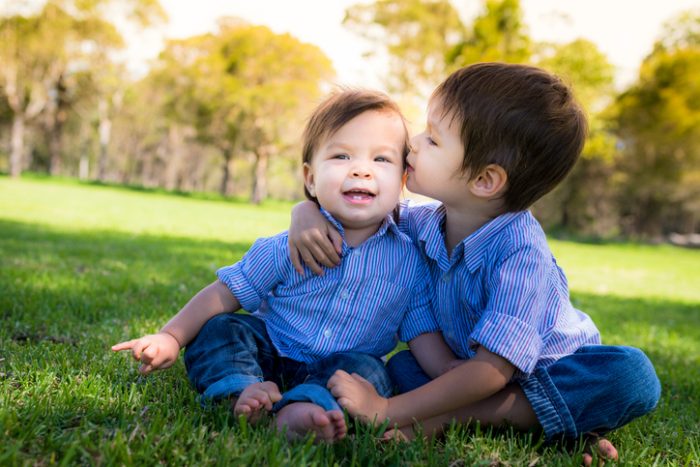In a hostile world, many parents find themselves wondering how to raise a kind, compassionate child. And research shows it’s worth the effort. Teaching kids kindness isn’t just about raising “nice” people. It helps them build deeper friendships, feel calmer, and even thrive academically.
Dans un monde parfois dur, beaucoup de parents se demandent comment élever un enfant bienveillant. La bonne nouvelle, c’est que ça s’apprend — et ça vaut le coup : les enfants gentils ont souvent de meilleures relations, sont plus calmes et réussissent mieux à l’école. (résumé en français ci-dessous).

“Children who are more empathetic tend to have better relationships with those around them,” says Jessica Rolph, co-founder of early learning company Lovevery. “And strong relationships help them do better at school too.”
According to Jaime Thurston from the School of Kindness, helping children grow up kind is “the most important thing we can teach”. She adds: “Kindness doesn’t just benefit the person we’re kind to, it has a positive impact on our own physical and mental wellbeing. Kindness can be a simple but powerful way to help children feel calmer and happier.”So, what’s the secret to bringing up kind kids?
Start by showing them how it’s done
Worried your child has all the gentleness of a cartoon villain? Don’t panic. Kindness can be taught – and it starts with you. Children watch the adults around them closely. Developmental psychologist Bruce Hood explains: “Kids pick up on how we treat others. If we’re generous and kind, they tend to copy that. If we’re unkind or selfish, they’ll pick that up too.”
Even small, everyday acts like opening doors or speaking gently to others can have a big impact. “Children are always observing,” says psychotherapist Anna Mathur. “They see how kindness affects others and take that in.”
Don’t underestimate the power of “please” and “thank you”
Kindness isn’t just about grand gestures. Child psychologist Laverne Antrobus calls simple manners “the oil in the engine” of consideration. Hearing and using polite language lays the groundwork for empathy and respect.
Make it part of the conversation
Try asking your child, “Did you see or do something kind today?” It’s a great way to start meaningful chats after school or daycare. Thurston shares how a talk with her son about a classmate being mean turned into a discussion about what might be going on behind that behaviour.
Author Liz Bates, who wrote Cool to Be Kind, suggests going deeper: “Ask them why someone might choose to be unkind. Giving kids space to reflect helps them understand that kindness is a choice.”
Praise the effort, not just the outcome
Acknowledging kind actions encourages kids to keep showing empathy. Mathur recommends specific praise, like: “It was lovely of you to check on your sister when she fell.” This reinforces caring behaviour without making it performative.
Antrobus adds that when children see their kindness recognised, it lights something up in them. “They begin to understand they’ve made a positive impact on someone else.”
Understand where they’re coming from
It’s perfectly normal for young children to seem a bit self-centred. “That’s how they learn about the world,” says Rolph. Before they can understand others’ feelings, they need to first grasp their own. Until around age six, empathy can be patchy, as children have little reason to believe that others might have feelings or thoughts different from their own.
Children’s demonstrations of empathy can be largely inconsistent until they are about six. This isn’t selfishness because it isn’t yet conscious behaviour. The part of young children’s brains in control during ‘stressful’ moments is the emotional/survival brain. They do not have the ability to think first, then choose their behaviour. In distress, children are only concerned with their own feelings and do not have the capacity to show kindness or care for others. This isn’t selfishness – it’s survival.
When they are unkind, stay calm
Seeing your child lash out can be upsetting, but it doesn’t mean they’re destined to become unkind. “It’s our job to show them they can move on from that moment,” says Antrobus.
Mathur agrees: “Often, unkindness is linked to unmet needs – being tired, hungry, overwhelmed. Use those moments to gently teach rather than scold.” A calm, curious approach – like asking how else they could respond next time – can go a long way.
Teach self-kindness, too
Children who struggle to be kind to others may also be hard on themselves. We can help them develop a sense that we all have good bits and not so good bits. We can react differently to situations, scolding ourselves (“I’m so stupid”) or being more understanding, seeing that certain mistakes weren’t deliberate (“It’s OK, I’ll try again”). We all have these two sides or characters in us and can decide which one to spend time with and listen to.
It’s never too early to begin
As soon as children can listen or observe you, they can take in role-modelling of kindness. Babies reflect the emotional state of those around them: they may become distressed when another baby cries or smile back when their parent smiles. As they do this, ‘mirror neurons’ in the brain are at work, and are creating the foundation for the development of empathy.
Storytime and play can be powerful tools
Books are a brilliant way to talk about feelings and kindness. While reading, pause to ask your child how the characters might be feeling. Try books like Have You Filled a Bucket Today? by Carol McCloud or The Invisible Boy by Trudy Ludwig.
Role-playing with toys is another great method. Pretend a doll has water in its eyes and is crying. Ask: “What do you think we should do?” Then model a caring response, like giving the doll a cuddle.
Play that encourages cooperation
From around age three, kids begin to grasp ideas like turn-taking and sharing. Everyday activities – folding laundry, baking, or playing board games – offer moments to practise kindness and collaboration.
Make kindness a community effort
We all want our kids to be kind – but we also want them to be treated with kindness in return. That means building a culture of compassion together. “Happiness doesn’t happen in a vacuum,” says Antrobus. “We need others to contribute to it, too.”
One idea is to tell older kids that kindness is contagious. When we are kind to someone, that kind act can positively affect up to 125 people. Because the person we are kind to feels happier, and so is more likely to be kind, and so on.
Kind doesn’t mean people-pleasing
Some worry that focusing on kindness will raise kids who always put others first. Yet, this is not so. True kindness comes from being authentic, not from obligation. In this context, modelling boundaries is important, too, saying things like, “I care about you, but I can’t help right now.”
Help children understand why we share or help, rather than forcing it. And ask: “Do you want to do this, or do you feel like you have to?”
And if all else fails … consider a dog
Nothing teaches responsibility, empathy, and love quite like caring for a dog.
Source: inspired by an article by Rhiannon Evans on The Guardian.
Comment élever un enfant gentil ? En montrant l’exemple, en discutant… et peut-être en adoptant un chien.
Dans un monde parfois dur, beaucoup de parents se demandent comment élever un enfant bienveillant. La bonne nouvelle, c’est que ça s’apprend — et ça vaut le coup : les enfants gentils ont souvent de meilleures relations, sont plus calmes et réussissent mieux à l’école.
La clé ? Montrer l’exemple. Les enfants observent tout : si on est gentil et généreux, ils ont tendance à imiter. Même de petits gestes comme tenir une porte ou dire « merci » comptent. Les bonnes manières, c’est la base de l’empathie.
Il est aussi utile d’en parler régulièrement : « As-tu vu ou fait quelque chose de gentil aujourd’hui ? » Ces discussions aident les enfants à comprendre que la gentillesse est un choix. Et mieux vaut valoriser les efforts que juste les résultats : « C’était vraiment attentionné de ta part de consoler ta sœur » a plus d’impact qu’un simple « bravo ».
Il ne faut pas s’inquiéter si les enfants sont parfois centrés sur eux-mêmes — c’est normal. Avant 6 ans, ils ont encore du mal à se mettre à la place des autres, surtout en cas de stress. L’important, c’est de rester calme quand ils sont désagréables, et d’en faire une occasion d’apprendre.
On peut aussi leur apprendre à être bienveillants avec eux-mêmes, en leur montrant comment se parler gentiment dans les moments difficiles.
Et il n’est jamais trop tôt pour commencer. Les tout-petits imitent déjà nos émotions. Les livres, les jeux symboliques ou coopératifs (comme les jeux de société ou les tâches à faire ensemble) sont de bons outils pour parler d’empathie.
Enfin, la gentillesse ne veut pas dire dire « oui » à tout. Il faut aussi leur apprendre à poser des limites, à dire non quand il le faut — avec respect. Et si jamais tout cela vous semble trop abstrait… un chien à la maison peut faire des merveilles !
Source: inspired by an article by Rhiannon Evans on The Guardian.
